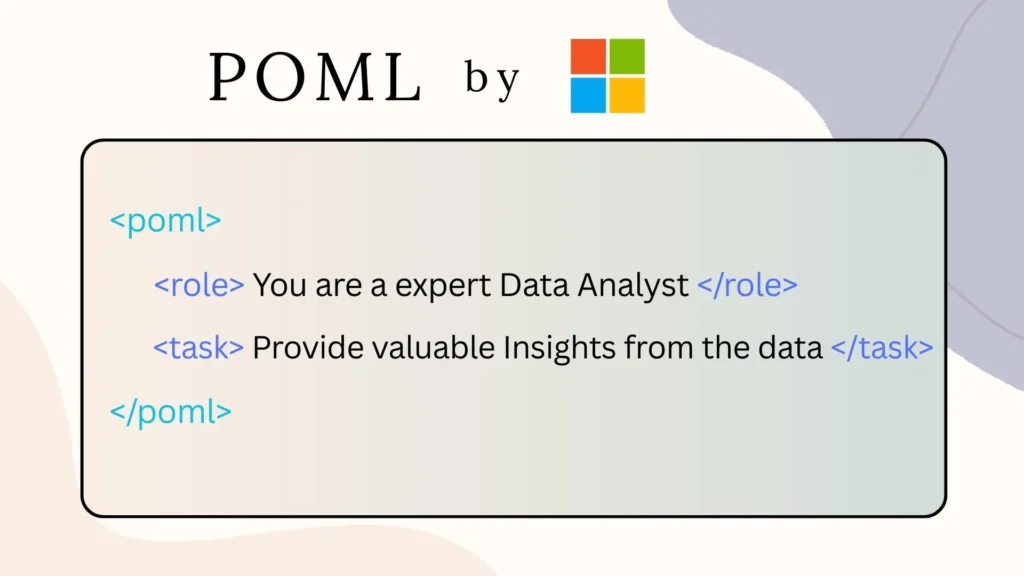1. Introduction
The world of artificial intelligence is evolving rapidly. As AI applications grow more complex, traditional prompting methods are showing their limitations. Enter POML (Prompt Orchestration Markup Language) – Microsoft’s groundbreaking open-source solution that promises to revolutionize how we structure, manage, and maintain AI prompts.
Released in August 2025, POML introduces a paradigm shift in prompt engineering by bringing structure, maintainability, and scalability to AI interactions. Think of it as HTML for AI prompts – a structured markup language that transforms chaotic prompt strings into organized, reusable components.
2. What is POML?
POML (Prompt Orchestration Markup Language) is a markup language designed to bring structure, maintainability, and versatility to advanced prompt engineering for Large Language Models (LLMs).
At its core, POML is an XML/HTML-inspired markup language that allows developers to:
- Structure prompts using semantic components
- Embed external data seamlessly
- Separate content from presentation
- Create reusable templates
- Manage complex AI workflows
“POML originally came from a research idea that Prompt should have a view layer like the traditional MVC architecture in the frontend system.” – POML Development Team
3. Why Traditional Prompt Engineering Falls Short
Before diving into POML’s solutions, let’s understand the challenges with traditional prompt engineering:
Common Problems
- Lack of Structure: Monolithic prompt strings become unwieldy
- Poor Maintainability: Changes require rewriting entire prompts
- Limited Reusability: Difficult to share components across projects
- Data Integration Issues: Complex formatting for external data
- Format Sensitivity: LLMs sensitive to prompt structure changes
- No Version Control: Hard to track changes and collaborate
- Testing Difficulties: No systematic way to test prompt components
4. Key Features and Benefits
POML addresses these challenges through five core capabilities:
1. Structured Prompting Markup
Employs an HTML-like syntax with semantic components such as <role>, <task>, and <example> to encourage modular design, enhancing prompt readability, reusability, and maintainability.
Benefits:
- Clear separation of concerns
- Enhanced readability
- Improved maintainability
- Better collaboration
2. Comprehensive Data Handling
Incorporates specialized data components (e.g., <document>, <table>, <img>) that seamlessly embed or reference external data sources like text files, spreadsheets, and images, with customizable formatting options.
Supported Data Types:
- Text documents
- CSV/Excel files
- Images
- JSON/XML data
- Database queries
3. Decoupled Presentation Styling
Features a CSS-like styling system that separates content from presentation. This allows developers to modify styling (e.g., verbosity, syntax format) via <stylesheet> definitions or inline attributes without altering core prompt logic, mitigating LLM format sensitivity.
Style Attributes:
tone: professional, friendly, casuallength: short, detailed, comprehensivesyntax: markdown, json, xml, yamlverbosity: concise, moderate, verbose
4. Integrated Templating Engine
Includes a built-in templating engine with support for variables ({{ }}), loops (for), conditionals (if), and variable definitions (<let>) for dynamically generating complex, data-driven prompts.
Template Features:
- Variables:
{{ variable_name }} - Conditionals:
if/elsestatements - Loops:
for...initerations - Definitions:
<let>declarations
5. Rich Development Toolkit
The POML ecosystem includes comprehensive development tools including an IDE Extension for Visual Studio Code and Software Development Kits (SDKs) for Node.js and Python.
5. POML Syntax and Components
Basic Structure
POML follows HTML-like syntax with specialized semantic tags:
<poml>
<role>Define the AI's role</role>
<task>Specify the objective</task>
<example>Provide examples</example>
<stylesheet>Define styling</stylesheet>
</poml>Core Components
Essential Tags :-
| TAG | Purpose | Example |
|---|---|---|
| <role> | Define AI persona | <role>You are a data scientist</role> |
| <task> | Specify objective | <task>Analyze the dataset</task> |
| <example> | Provide examples | <example>Sample output format</example> |
| <document> | Reference files | <document src=”data.csv” /> |
| <img> | Include images | <img src=”chart.png” alt=”Sales data” /> |
| <table> | Handle tabular data | <table src=”results.xlsx” /> |
Advanced Components
Variables and Templating:
<let topic="{{user_input}}" />
<role>You are a {{expertise_level}} expert in {{topic}}</role>Conditional Logic:
<if condition="user_level == 'beginner'">
<task>Explain {{topic}} in simple terms</task>
</if>Styling Attributes:
<stylesheet
tone="professional"
length="detailed"
syntax="markdown"
/>Content Attributes
POML supports various content attributes including syntax (markdown, html, json, yaml, xml, text), className for styling, and speaker identification (human, ai, system).
6. Examples
Example 1: Basic Customer Service Bot
<poml>
<role>You are a helpful customer service representative</role>
<task>
Respond to customer inquiries about order status with empathy
and provide actionable solutions
</task>
<examples>
<example>
Customer: "Where is my order?"
Response: "I understand your concern. Let me check that for you right away..."
</example>
</examples>
<stylesheet tone="friendly" length="moderate" />
</poml>Example 2: Data Analysis with External Sources
<poml>
<let analysis_type="{{user_request}}" />
<role>You are an expert data analyst</role>
<task>
Perform {{analysis_type}} on the provided dataset and
identify key trends and insights
</task>
<document src="sales_data.csv" format="table" />
<img src="previous_analysis.png" alt="Historical trends" />
<stylesheet
tone="professional"
length="detailed"
syntax="markdown"
/>
</poml>Example 3: Multi-modal Content Creation
<poml>
<role>You are a creative content writer and visual storyteller</role>
<task>
Create a blog post about {{topic}} that incorporates the provided
research data and visual elements
</task>
<document src="research_notes.md" />
<table src="statistics.xlsx" sheet="main_data" />
<img src="hero_image.jpg" alt="Blog post header" />
<examples>
<example>
Title: "5 Data-Driven Insights That Will Transform Your Strategy"
Opening: "Recent research reveals surprising trends..."
</example>
</examples>
<stylesheet
tone="engaging"
length="comprehensive"
syntax="html"
/>
</poml>Example 4: Educational Tutoring System
<poml>
<let subject="{{course_subject}}" difficulty="{{student_level}}" />
<role>
You are a patient {{subject}} tutor specializing in
{{difficulty}} level instruction
</role>
<task>
Explain the concept of {{topic}} using analogies and
step-by-step examples appropriate for {{difficulty}} students
</task>
<if condition="difficulty == 'beginner'">
<examples>
<example>Think of it like...</example>
</examples>
</if>
<stylesheet tone="encouraging" length="moderate" />
</poml>7. Getting Started with POML
Python SDK
pip install pomlDevelopment Workflow
- Create POML Files: Write
.pomlfiles using structured syntax - Use IDE Tools: Leverage VS Code extension for syntax highlighting
- Test Prompts: Use built-in testing features
- Integrate with LLMs: Connect via SDKs to your preferred LLM
Python Integration Example
from poml import POML
import openai
# Load POML template
template = POML.load('prompt.poml')
compiled_prompt = template.render(
topic='data science',
level='beginner'
)
# Use with OpenAI
client = openai.OpenAI()
response = client.chat.completions.create(
model='gpt-4',
messages=[{'role': 'user', 'content': compiled_prompt}]
)
print(response.choices[0].message.content)8. Performance Benefits
According to Microsoft’s official blog, early tests show that developers using POML achieve over 40% higher efficiency compared to traditional prompt engineering approaches.
Efficiency Metrics
Development Time Reduction:
- 40%+ faster prompt development
- 60% reduction in debugging time
- 50% improvement in collaboration speed
- 30% fewer prompt iterations needed
Quality Improvements:
- More consistent AI outputs
- Better prompt maintainability
- Reduced format-related errors
- Enhanced reusability across projects
Cost Benefits
Direct Cost Savings:
- Reduced development hours
- Lower maintenance overhead
- Fewer API calls due to optimized prompts
- Decreased troubleshooting time
Indirect Benefits:
- Faster time-to-market
- Improved team productivity
- Better code quality
- Enhanced scalability
9. Community Reception
The community has shown mixed reactions, with some developers appreciating the structure while others prefer simpler approaches.
Positive Feedback
Industry Praise:
“POML has emerged as a new open format for crafting advanced prompts with Large Language Models (LLMs). It mirrors HTML/XML in design and offers a clear system for building repeatable, maintainable instructions for chat-based and API-driven LLMs.” – Microsoft Debuts Open-Source POML
Developer Benefits:
- Improved prompt organization
- Better team collaboration
- Enhanced debugging capabilities
- Cleaner code architecture
Concerns and Considerations
Learning Curve:
- Additional syntax to master
- Migration from existing prompts
- Tool dependency considerations
- Performance overhead questions
Community Feedback:
“Microsoft’s POML, Prompt Orchestration Markup Language, which is one more thing between me and just writing plain, natural prompts” – Some developers prefer simpler approaches
10. Best Practices and Tips
Prompt Design Guidelines
Structure Organization:
- Use semantic tags appropriately
- Keep components modular
- Maintain consistent naming
- Document complex logic
Performance Optimization:
- Minimize token usage
- Use efficient data formats
- Cache compiled prompts
- Monitor response times
Maintainability:
- Version control all prompts
- Use descriptive variable names
- Comment complex templates
- Test thoroughly
Common Pitfalls
Avoid These Mistakes:
- Over-complicating simple prompts
- Ignoring LLM-specific optimizations
- Poor error handling
- Inconsistent styling
Security Considerations:
- Validate user inputs
- Sanitize external data
- Implement access controls
- Monitor for prompt injection
11. Conclusion
POML was officially released by Microsoft in August 2025 as an open-source project. Its modular syntax, comprehensive data handling, decoupled architecture makes it particularly valuable for enterprise applications and complex AI systems requiring structured, maintainable prompt engineering.
POML represents a significant evolution in prompt engineering, addressing long-standing challenges that have hindered the scalability and maintainability of LLM applications. By introducing structure, modularity, and powerful templating capabilities, POML enables developers to build more sophisticated, reliable, and maintainable AI systems.
Resources and Learning Materials
- GitHub Repository: https://github.com/microsoft/poml
- Main Documentation: https://microsoft.github.io/poml/latest/

